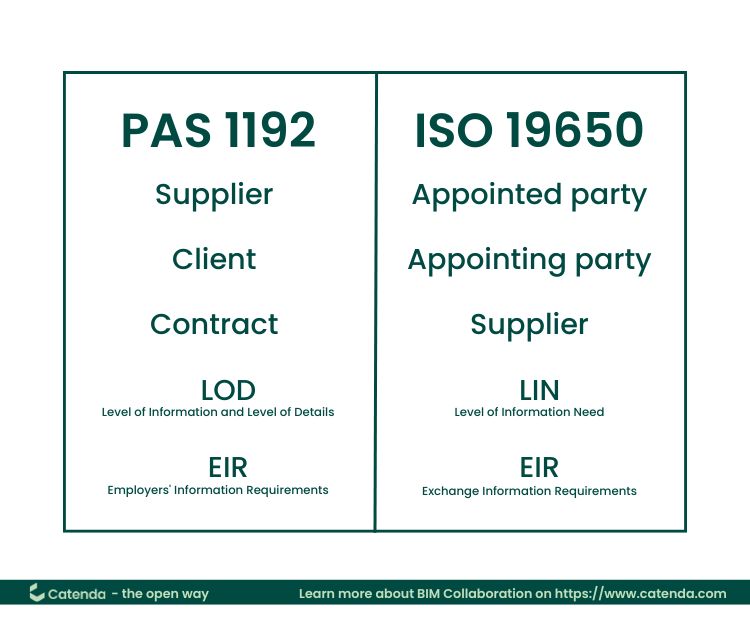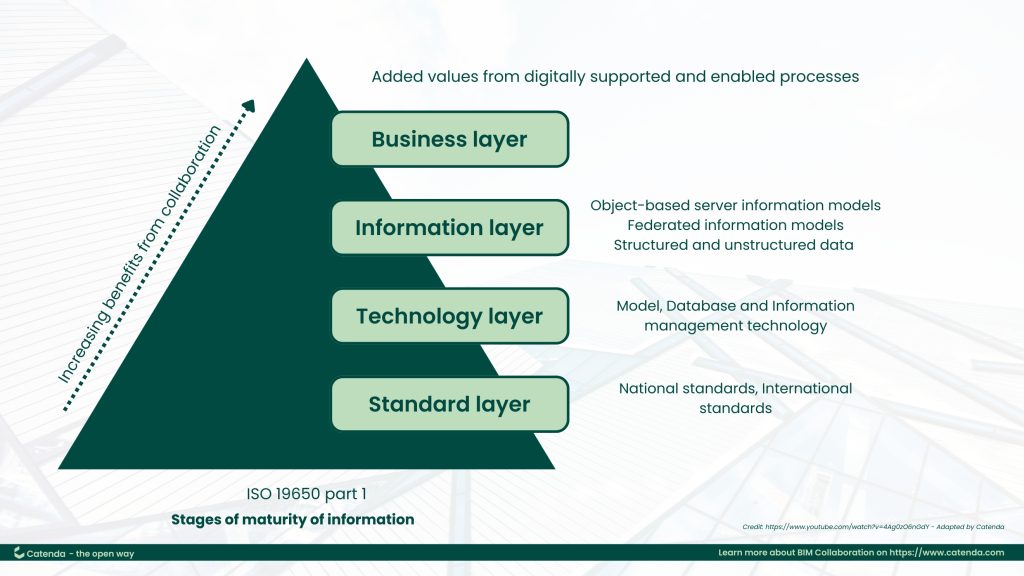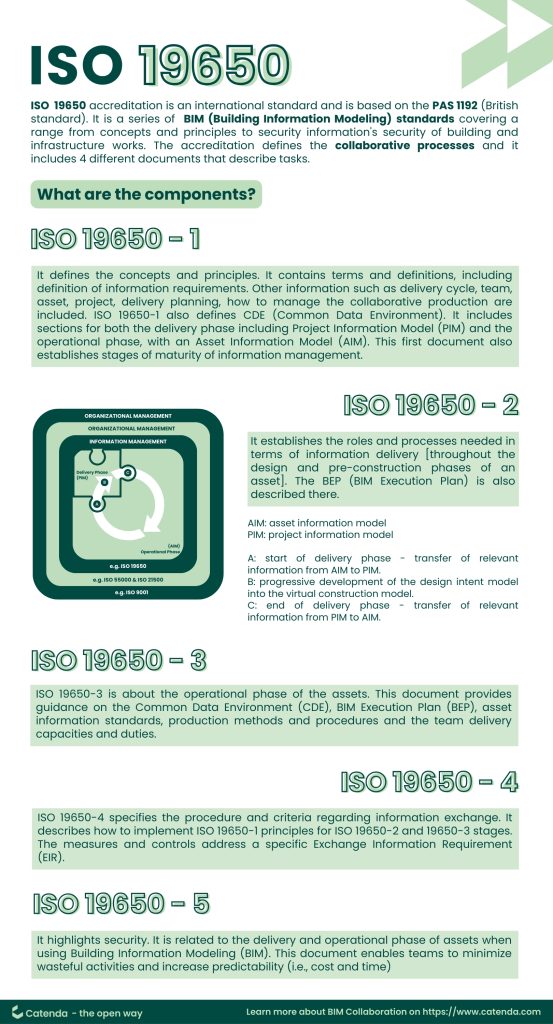What does ISO 19650 mean?
ISO 19650 accreditation is an international standard and is based on the older PAS 1192 (British standard). PAS 1192 (Publicly Available Specifications) defined the guidelines, codes of practices and standards that were developed to fulfil the immediate needs of the building industry.

ISO 1950 is a series of BIM (Building Information Modeling) standards that cover from concepts and principles to security information about buildings and civil engineering works. The accreditation defines the collaborative processes and it includes 4 different documents that describe tasks.
ISO 19650-1
The ISO 19650-1 defines the concepts and principles. It contains terms and definitions, including definition of information requirements. Other information such as delivery cycle, team, asset, project, delivery planning, how to manage the collaborative production are included. ISO 1950-1 also contains CDE (Common Data Environment) solutions and workflow.
It includes sections for both the delivery phase including Project Information Model (PIM) and the operational phase, with an Asset Information Model (AIM).
This first document also establishes stages of maturity of information management.

ISO 19650-2
ISO 19650 – 2 outlines the delivery phase of the assets. It includes information about the management during the delivery phase of assets and also information about the management process. The BEP (BIM Execution Plan) is also described there.

Legend:
- AIM: asset information model
- PIM: project information model
- A: start of delivery phase — transfer of relevant information from AIM to PIM
- B: progressive development of the design intent model into the virtual construction model
- C: end of delivery phase — transfer of relevant information from PIM to AIM
ISO 19650-3
ISO 19650 – 3 is about the operational phase of the assets. This document gives guidelines about the Common Data Environment (CDE), BIM Execution Plan (BEP), asset information standards, production methods and procedures and the team delivery capacities and capabilities.
ISO 19650-4
ISO 19650-4 specifies the procedure and criteria regarding information exchange. It describes how to implement ISO 19650-1 principles for ISO 19650-2 and 19650-3 stages. The measures and controls address a specific Exchange Information Requirement (EIR).
ISO 19650-5
ISO 19650 – 5 highlights security. It is related to the delivery and operational phase of assets when using Building Information Modeling (BIM). This document enables teams to minimise wasteful activities and increase predictability (i.e., cost and time).
During the ISO 19650 process, the following documents are needed:
- OIR – Organizational Information requirements
- PIR – Project Information Requirements
- EIR – Exchange Information Requirements
- AIR – Asset Information Requirements
- BEP – BIM Execution Plan – You can download a free template here.
- RM – Responsibility Matrix
- TIDP – Task Information Delivery Plans
- MIDP – Master Information Delivery Plan
- RACI – Responsible, Accountable, Consulted, Informed
ISO 19650 and Common Data Environment (CDE)
The definition and importance of CDE in ISO 19650
The Common Data Environment (CDE), as defined by ISO 19650, is the agreed source of information for a given project or asset, responsible for collecting, managing, and disseminating each information container through a managed process. The CDE serves as a cloud-based data platform to store construction project information. It provides project participants access to this information based on their requirements, contractual obligations, and authorization level. This centralization of data contributes to improved collaboration, enhanced information management, and increased efficiency, thus playing an instrumental role in the effective BIM management in construction.
Managing CDE under ISO 19650 standards
Managing the Common Data Environment (CDE) under ISO 19650 standards entails establishing comprehensive protocols to ensure effective information management.
A key aspect of this is access and permissions management. This means setting rules for who can view, modify, or delete information within the CDE.
Another crucial element is the auditability of logs, which document how data is manipulated and shared. Transparency in these processes is vital.
Finally, a CDE must be supported by a combination of technical solutions and process workflows, as suggested by ISO 19650. It is not only about the software but also the processes that enable efficient information management.
The role of CDE in achieving compliance with ISO 19650
The Common Data Environment (CDE) plays a pivotal role in achieving compliance with ISO 19650. It acts as a centralized repository for collecting, managing, and disseminating all graphical and non-graphical information throughout a project’s lifecycle. As such, the CDE is vital for ensuring effective collaboration, decision-making, and overall project management.
To achieve compliance, contractors must establish comprehensive protocols within the CDE, including user access and permissions management. This ensures that data is shared, stored, and managed effectively, thereby aligning with the ISO 19650’s emphasis on standardized processes and guidelines for efficient information management.
Moreover, understanding the ISO 19650 standards is crucial before implementing them. This includes understanding the functional characteristics of a CDE as defined by ISO 19650, such as its role as the “agreed source of information for any given project or asset”. By thoroughly understanding these standards, BIM teams can ensure proper utilization of the CDE, thereby facilitating ISO 19650 compliance.




